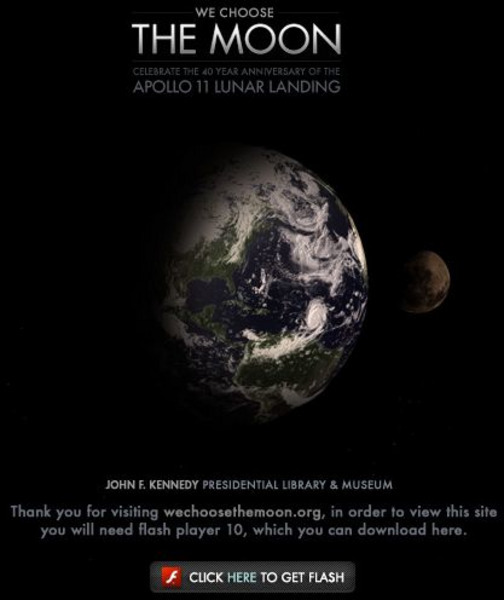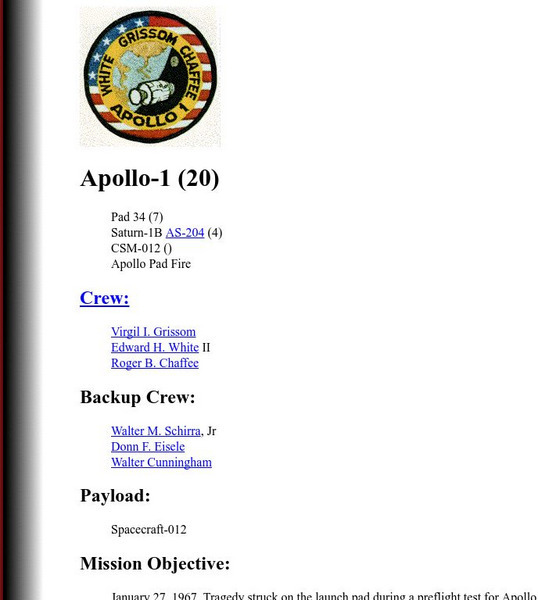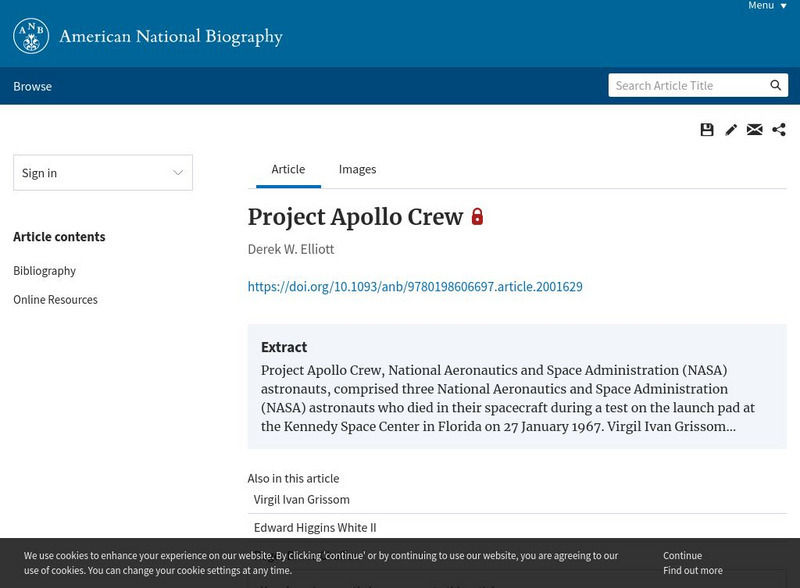Hi, what do you want to do?
Curated OER
Activity on United States Moon Landing: Apollo 11
Students use the World Wide Web to access additional information needed to complete a set of questions. They demonstrate an understanding of latitude and longitude by interpreting a lunar map.
Curated OER
Introduction of the Lunar Relief Map Project
Young scholars investigate the geographic features of the surface of the moon. In this lunar relief map lesson, students watch and discuss the Apollo II Moon landing and make preliminary plans for their lunar maps.
Curated OER
How Much Would You Weigh On Distant Planets?
High schoolers study the effects of gravity on the planets of the Solar System. They view movies from the lunar Apollo missions, calculate their own weight on other planets, and propose what they might weigh on newly discovered planets...
NASA
Transportation and Space: Reuse and Recycle
What can I use in space? The three-lesson unit has groups research what man-made or natural resources would be available during space exploration or habitation. Team members think of ways that resources can be reclaimed or reused in...
Curated OER
Atmospheric Shielding from Radiation II
In this radiation worksheet, students calculate the total shielding along several specific directions defined by the angles. This worksheet has 3 problems to solve.
Curated OER
Milestones in the Space Program
Students brainstorm names of astronauts from NASA space missions. They are explained that the Cold War was not actually a war but pervasive tension that existed between the United States and the Soviet Union for several decades...
Curated OER
An Exploration on the Moon
In this Google Earth worksheet, students search the site and answer short answer questions about the moon. Students answer 18 questions.
Curated OER
Rocket Science 101
Students explore the aspects of Newton's First and Third Laws of Motion as they conduct controlled rocketry experiments and analyze the Mars Mission in terms of the principles of rocketry.
Curated OER
Exploring the Night Sky: Summer
Students explain how moon phases occur. They describe and explain at least two common misconceptions that people have about the moon. Students explain what a star is. They explain 3 ways that the night sky has been used throughout history.
Curated OER
The Art of Studying Art
Students explain the value of different genres of art. In this art lesson, students describe the differences in various genres of art and make comparisons between them. Students choose an art genre and create an original work of art...
Curated OER
Mountain of Myths
Students listen to mythical stories about Greek Mythology. In this myths lesson plan, students actively listen to myths, examine why it would be a myth and analyze the characters in the stories.
Curated OER
Exploring the Night Sky: Fall/Winter
Students explain how moon phases occur. They explain three ways that the night sky has been used through history. Students locate some of the constellations in the night sky. They discuss stories and myths surrounding stars.
Curated OER
Proofreading Activity: "The Twentieth Century"
In this proofreading worksheet, students mark infinitives, prepositional phrases, subjects and verbs in a paragraph titled "The Twentieth Century,"then edit for missing commas.
Curated OER
Cold War - The Space Race
In these Cold War worksheets, students read about the space race between the United States and Russia. Students also read about the first man on the moon and answer 8 questions about the texts.
Curated OER
Classical Art
Students study the evolution of Greek and Roman art in pottery and human form. They examine how the artistic evolution is related to discoveries in science and travel through the lessons in this unit.
Curated OER
When in Greece, Do as the Greeks Do
Students examine the contributions of ancient Greeks in this five lesson unit. The explorations reveal how Greece shaped our stories, our modern language, and our society. The study of the Greek myth forms the basis of this unit.
Curated OER
Atmospheric Shielding from Radiation III
For this radiation worksheet, students compare the efficiency of planetary atmospheres to shielding from radiation. This worksheet has 2 problems to solve.
Curated OER
The Vocabulary of Space
Students build their knowledge and understanding of vocabulary related to space. In this space instructional activity, students discuss four categories of words and phrases related to space.
Other
We Choose the Moon
Feel like you were right there when Apollo 11 was launched as you listen to the actual Mission Control audio from that date. The mission is further brought to life by photos and video of the event as well as a virtual animation. Go...
Smithsonian Institution
National Air and Space Museum: Apollo to the Moon
This resource offers an in-depth exploration of the U.S. space program and the role President John F. Kennedy took in setting the agenda for manned space flight to the moon.
NASA
Nasa: Ed White Apollo 1 Summary
NASA report on Apollo 1 where Virgil "Gus" Grissom, Roger Chaffee, and Ed White II were killed in a fire inside the Command Module of the Apollo spacecraft. Links to other Web sites with more information are included.
Other
American National Biography: Project Apollo Crew
This site details the lives of the project Apollo crew, as well as the mishap which resulted in their death.
NASA
Nasa: Astronaut Biography: Edward H. White, Ii
Official NASA biography of astronaut, Edward H. White II, killed in the Apollo spacecraft flash fire during a launch pad test in 1967.
US National Archives
Nara: American Originals: President Nixon's Resignation Letter
This is a short site that highlights the diary of Nixon on July 20, 1969, the day of the historic moon walk. There's also a picture of Nixon talking to the Apollo II astronauts while they are on the moon.



























